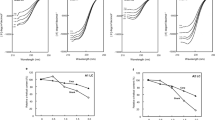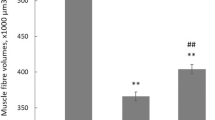Abstract
WATER extraction of an acetone-dried muscle powder preparation of rabbit1 is one of the standard methods of producing a solution of globular or G-actin. Such a solution possesses no birefringence of flow and has a low specific viscosity2. On making this solution 0.1 M with respect to potassium chloride, 0.001 M with respect to Mg++ and allowing to stand, a marked birefringence of flow develops and the solution has a considerably increased specific viscosity. These changes have been classically considered to be a result of the polymerization of the G-actin, as extracted, to the fibrous or F-form.
This is a preview of subscription content, access via your institution
Access options
Subscribe to this journal
Receive 51 print issues and online access
$199.00 per year
only $3.90 per issue
Buy this article
- Purchase on Springer Link
- Instant access to full article PDF
Prices may be subject to local taxes which are calculated during checkout
Similar content being viewed by others
References
Barany, M., Barany, K., and Guba, F., Nature, 179, 818 (1957).
Szent-Györgyi, A., in Chemistry of Muscular Contraction (Academic Press, 1951).
Martinosi, A., Gouvea, M. A., and Gergely, T., J. Biol. Chem., 235, 1707 (1960).
Tsuboi, K. K., and Hayashi, T., Arch. Biochem. Biophys., 100, 313 (1963).
Author information
Authors and Affiliations
Rights and permissions
About this article
Cite this article
GRAHAM, G. Direct Extraction of Actin in the Fibrous Form from Fish Muscle. Nature 203, 405–406 (1964). https://doi.org/10.1038/203405b0
Issue Date:
DOI: https://doi.org/10.1038/203405b0
Comments
By submitting a comment you agree to abide by our Terms and Community Guidelines. If you find something abusive or that does not comply with our terms or guidelines please flag it as inappropriate.



